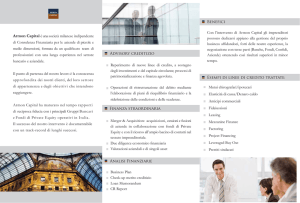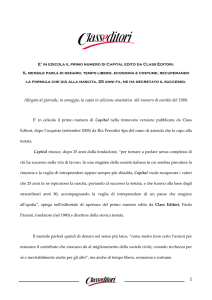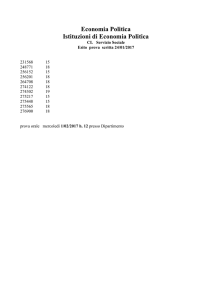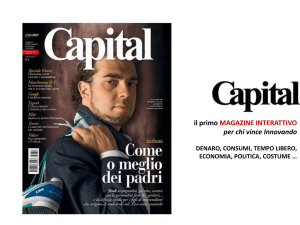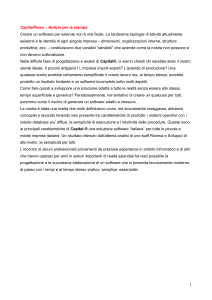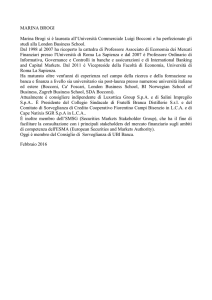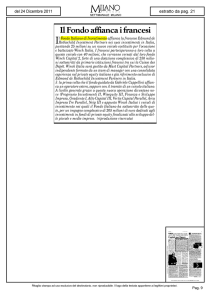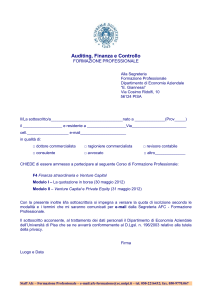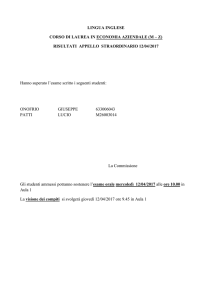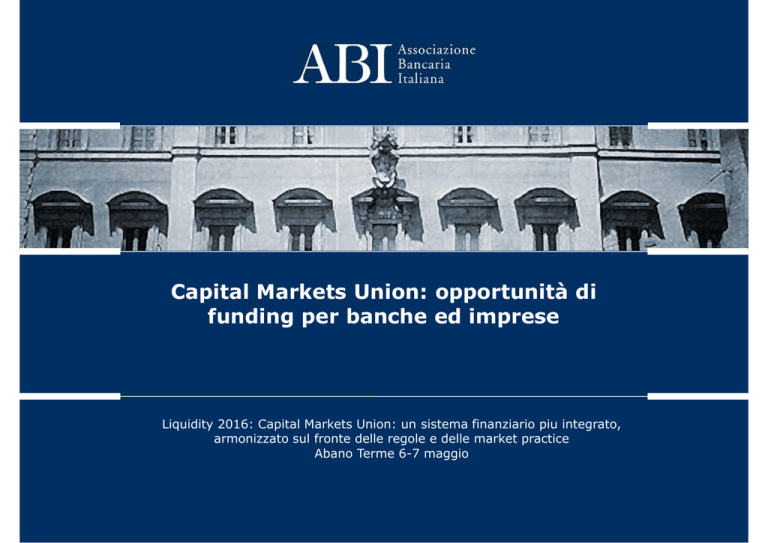
Capital Markets Union: opportunità di
funding per banche ed imprese
Liquidity 2016: Capital Markets Union: un sistema finanziario piu integrato,
armonizzato sul fronte delle regole e delle market practice
Abano Terme 6-7 maggio
CAPITAL MARKETS UNION
La Capital Markets Union
Nel febbraio 2015 la Commissione Europea ha avviato il Progetto della
Capital Markets Union (CMU), volto a creare nei 28 Stati Membri della
Unione Europea mercati dei capitali ampi e integrati, con i seguenti
principali obiettivi
Sviluppare un
mercato
finanziario per le
imprese che
integri quello dei
finanziamenti
bancari
Aumentare le
informazioni
sulle opportunità
di investimento
e sui rischi
soprattutto sulle
PMI
Applicare in
modo efficace e
coerente il
Single RuleBook per i
servizi finanziari
10/05/2016
Sbloccare i
capitali bloccati
in Eu e metterli
a disposizione
dell’economia
CMU
Migliorare la
comprensione
degli
investimenti
soprattutto per
gli investitori
retail
Eliminare le
barriere agli
investimenti negli
SM e negli
investimenti
transnazionali
2
CAPITAL MARKETS UNION
I limiti del mercato dei capitali europeo
-
Elevate differenze nello sviluppo dei mercati dei capitali nei paesi membri EU
Bassa fiducia degli investitori nell'UE che si traduce in diversi modelli comportamentali
di risparmio e investimento
Dal lato della domanda, ci sono barriere
all’accesso ai mercati dei capitali che
riguardano:
-
-
-
alti costi di accesso, in particolare per le
PMI, start up, e difficoltà di finanziamento
per i progetti infrastrutturali
livelli non adeguati di informazione
disponibile per assumere decisioni di
investimento in tutta l'UE soprattutto nel
caso di PMI
investitori che operano esclusivamente su
loro mercati nazionali
Dal lato dell'offerta, vi sono vincoli al flusso di
risparmio verso strumenti del mercato dei
capitali da parte di investitori istituzionali, retail
e internazionali.
Questi vincoli sono:
alti costi di costituzione e di marketing dei
fondi transnazionali;
frammentazione del mercato del capitale di
rischio nell'UE
carenza di fiducia degli investitori al
dettaglio nei mercati finanziari e negli
intermediari a causa della crisi.
Questi problemi sono particolarmente gravi nei
Paesi che sono stati più colpiti dalla crisi.
33
CAPITAL MARKETS UNION
La situazione di partenza
I mercati dei capitali europei sono
meno sviluppati rispetto a molti
altri paesi
In Europa i mercati dei capitali
hanno livelli di sviluppo diversi tra
loro
Fonte: Commissione Europea – Dati 2013
44
CAPITAL MARKETS UNION
USA vs EU
I mercati azionari USA sono quasi il doppio in
termini di dimensioni (la capitalizzazione di borsa
è 138% del PIL degli Stati Uniti contro il 64,5%
nella UE nel 2013). In rapporto alle dimensioni
dell'economia, la capitalizzazione di borsa in Cina
supera quella UE (74% del PIL in Cina, rispetto al
64,5% nella UE nel 2013).
Il mercato dei titoli di debito corporate USA è pari a
tre volte quello Europeo (2013: il totale outstanding
dell'indebitamento corporate è 40,7% del PIL degli Stati
Uniti contro il 12,9% nella UE)
Le emissione di cartolarizzazione in Europa sono state
pari a circa € 216 mld nel 2014 (€ 180 mld nel 2013)
rispetto a € 594 mld nel 2007.
Il mercato dei private placement USA è
quasi tre volte più grande di quello UE (2013: il
volume di emissione è stato pari a 50 miliardi $
rispetto a 15 miliardi € nell'UE).
Il mercato del venture capital è circa cinque
volte più grande negli Stati Uniti che in Europa, in
termini di importi investiti..
Fonte: Commissione Europea
10/05/2016
5
CAPITAL MARKETS UNION
Il mercato dei capitali italiano in cifre
Mercato azionario
capitalizzazione complessiva 2014: 486 miliardi €
(+14 mld anno precedente) pari al 9% della zona
EU (FR 30,4%, DE 27,3%)
Num. Totale società quotate dic 2014: 342 (+ 16
ultimo anno)
di cui: Soc. quotate AIM dic 2014: 57 (+ 21
ultimo anno)
Scambi giornalieri azioni 2014: 2,8 mld €
(Fonte: Borsa Italiana)
Risparmio gestito
•
Patrimonio complessivo 2014: 1.585 mld €
•
Raccolta totale 2014: 133,8 mld €
•
di cui: Fondi aperti: 91,5 mld €
Fondi chiusi: 0,9 mld €
Gestioni Patrimoniali: 41,4 mld €
•
Nazionalità fondi: diritto italiano 35%/estero 65 %
(Fonte: Assogestioni)
Mercato dei titoli di debito corporate
•
Numero imprese emittenti nel 2013: 22
•
Valore emissioni obbligazioni nel 2013: 21 mld €
•
Emissioni di minibond (< 50 mln €) nel 2014: 54
•
Valore emissioni minibond nel 2014: 606 mln €
Private Equity
•
Raccolta 1° sem. 2014: 434 mln € (+167,3%,
anno precedente)
•
Raccolta dagli investitori esteri: 51%
•
Ammontare investito 1°sem 2014: 1890 mln €
(3.430 mln € nel 2013)
(Fonte: AIFI)
Cartolarizzazioni (inclusi covered bonds)
•
Valore totale emissioni: 57,4 mld € (2014) - 53,6
mld € (2013) – 111,5 mld € (2012) – 90 mld €
2011)
(fonte: Securitisation.it)
Covered Bonds
•
Valore Totale Outstanding: 129 mld € (2013) –
126,7 mld € (2012) – 63,7 mld € (2011)
•
Valore Totale emissioni: 28,7 mld € (2013) – 70,6
mld € (2012) – 35,1 mld € (2011)
(Fonte: ABI)
(Fonte: Banca d’Italia, Borsa Italiana)
10/05/2016
6
CAPITAL MARKETS UNION
Le priorita della CMU
Priorità di
breve periodo
Priorità di
medio – lungo
periodo
10/05/2016
7
CAPITAL MARKETS UNION
Priorità di breve periodo
• Ridurre le barriere all'accesso ai mercati dei capitali attraverso
•
•
•
•
la revisione della Direttiva sul Prospetto per i titoli
offerti/negoziati su mercati regolamentati
Ampliare la base degli investitori per le PMI attraverso il
miglioramento delle informazione sul merito di credito delle
PMI (set minimo comune di informazioni comparabili per il
reporting e la valutazione del credito)
Costruire un mercato della cartolarizzazione semplice,
trasparente e sostenibile che possa collegare in maniera più
efficace il mercato del credito con quello dei capitali
Sviluppare i mercati EU del private placement, per facilitare la
disponibilità di finanziamenti per le medie e grandi imprese
Stimolare gli investimenti a lungo termine, incoraggiando gli
investitori a far partire gli ELTIFs (European Long-Term
Investment Funds)
8
CAPITAL MARKETS UNION
Priorità di medio-lungo periodo
Sono individuate 3 aree di intervento:
1 - Migliorare l'accesso ai finanziamenti per tutte le imprese
europee, in particolare per le PMI, e per gli investimenti
infrastrutturali
2 - Sviluppare l’offerta di capitale: aumentare e diversificare le
risorse finanziarie da parte degli investitori (istituzionali e retail)
nell'Unione europea e in tutto il mondo
3 - Rendere la catena degli investimenti più efficace e meno
costosa (sia a livello nazionale sia cross border)
9
CAPITAL MARKETS UNION
1 - Migliorare l’accesso ai finanziamenti
Risolvere i problemi di accesso alle
informazioni
Standardizzare i mercati
• Sviluppare regole contabili mirate per le
• Sviluppare un mercato dei covered bond
•
•
PMI
Incoraggiare le banche a dare un
feedback alle PMI il cui credito è stato
rifiutato per creare consapevolezza su
forme alternative al credito bancario
Creare
un
«European
Investment
Project Pipeline», un sito web dedicato
per facilitare l'accesso alle informazioni
per gli investitori circa i progetti
infrastrutturali
10/05/2016
•
•
•
EU più integrato per fornire agli investitori
opportunità di investimento sicure e
liquide, sulla base dell'esperienza maturata
a livello nazionale;
Maggiore standardizzazione delle emissioni
di corporate bonds per sviluppare un
mercato secondario più liquido delle
obbligazioni societarie;
Sostenere lo sviluppo di green bond
Consentire lo sviluppo di mezzi alternativi
di finanziamento (es. crowdfunding)
10
CAPITAL MARKETS UNION
2 - Sviluppare e diversificare l’offerta
Promuovere gli investimenti istituzionali
Accrescere gli investimenti retail
• Valutare
• Migliorare la partecipazione transfrontaliera
come
ridurre
i
costi
regolamentazione per la creazione
commercializzazione
transfrontaliera
fondi di investimento (UCITS)
di
e
di
• Possibile revisione delle norme prudenziali
•
•
per gli investimenti in infrastrutture da
parte di banche e assicurazioni
• Adozione di norme (in discussione) per
rimuovere gli ostacoli ai fondi pensione che
investono più in attività a lungo termine
• Aumentare l'offerta di fondi di venture
•
capital in tutta l'UE attraverso misure volte
a far decollare gli «EU Venture Capital
Funds»
Aumentare le dimensioni dei fondi di
venture capital e le possibilità di uscita per
gli investitori
10/05/2016
degli investitori retail nei fondi UCITS
Ulteriore contributo delle ESA alla tutela
degli investitori
Riflettere su come rafforzare la concorrenza
transfrontaliera nel settore dei servizi
finanziari al retail per offrire più vantaggi per
i consumatori
Attrarre gli investimenti internazionali
• Mantenere alti standard europei di integrità
•
del mercato, stabilità finanziaria e tutela
degli
investitori
e
mercati
aperti
e
competitivi a livello globale per attirare gli
investimenti esteri
Individuare quali misure possono rendere
l'UE un luogo più attraente nel quale
investire e facilitare l'accesso delle imprese
europee ai mercati dei paesi terzi
11
CAPITAL MARKETS UNION
3 - Rendere la catena degli investimenti più efficace /1
Single
rulebook,
concorrenza
enforcement
e
• Evitare il gold-plating, lavorare con gli
•
•
•
•
Stati membri e le Autorità di Vigilanza
europee per far rispettare la legislazione
Utilizzare
i
poteri
in
materia
di
concorrenza per rimuovere le barriere
all'entrata per i concorrenti e garantire
l'accesso alle infrastrutture di mercato
Affrontare gli ostacoli ai flussi di
investimento,
es.
le
restrizioni
ingiustificate da parte degli Stati membri
Assicurare la convergenza delle prassi di
vigilanza
Rivedere il funzionamento e l‘attività delle
Autorità di vigilanza europee, la loro
governance
e
i
meccanismi
di
finanziamento
10/05/2016
Dati e reporting
• Garantire la creazione di un «consolidated
•
tape» per i mercati azionari (MIFID)
Individuare approcci IT alla supervisione e
al reporting
Infrastrutture di mercato e Securities
Law
• Proposta legislativa sul «recovery and
•
•
resolution» per le controparti centrali
Modifiche alla «securities law» per
contribuire a rendere i mercati dei capitali
più integrati
Migliorare il flusso cross border del
collateral
12
CAPITAL MARKETS UNION
3 - Rendere la catena degli investimenti più efficace /2
Diritto societario, diritto fallimentare e
fisco
Tecnologia
Tecnologia
• Revisione dei diritti degli azionisti direttiva
• Gli
Gli
•
•
•
(in corso) per incoraggiare gli investitori a
fornire alle imprese più capitali a lungo
termine
Riforma del diritto societario per superare
ostacoli allo stabilimento transfrontaliero
delle aziende
Ridurre le differenze tra le discipline
nazionali in tema di insolvenza, al fine di
diminuire l'incertezza giuridica e dare agli
imprenditori una «seconda possibilità»
Le differenze nei regimi fiscali possono
ostacolare lo sviluppo di un mercato unico
dei capitali (es. differenze di trattamento
fiscale del debito vs azioni)
10/05/2016
•
investimenti nelle
nelle cosiddette
cosiddette
investimenti
imprese "Fintech"
"Fintech" o
o in
in servizi
servizi
imprese
finanziari innovativi
innovativi che
che utilizzano
utilizzano
finanziari
tecnologie digitali
digitali sono
sono in
in rapida
rapida
tecnologie
crescita
crescita
Come può
può sostenere
sostenere l'Unione
l'Unione europea
europea
Come
lo sviluppo
sviluppo di
di nuove
nuove tecnologie,
tecnologie, e
e di
di
lo
integrare nel
nel diritto
diritto societario
societario ii
integrare
vantaggi della
della digitalizzazione?
digitalizzazione?
vantaggi
13
CAPITAL MARKETS UNION
L’ACTION PLAN
Financing for innovation, start-ups and non-listed companies
Proposal for pan-European venture capital fund-of-funds and multicountry funds
Q2 2016
Revise EuVECA and EuSEF legislation
Study on tax incentives for venture capital and business angels
Q3 2016
2017
Strengthen feedback given by banks declining SME credit applications
Q2 2016
Support venture capital and equity financing
Map out existing local or national support and advisory capacities across
the EU to promote best practices
Investigate how to develop or support pan-European information systems
Overcome information barriers to SME investment
Promote innovative forms of corporate financing
2017
2017
Report on crowdfunding
Q1 2016
Develop a coordinated approach to loan origination by funds and assess
the case for a future EU framework
Q4 2016
Making it easier for companies to enter and raise capital on public markets
Proposal to modernise the Prospectus Directive
Review regulatory barriers to SME admission on public markets and
Strengthen access to public markets
Support equity financing
10/05/2016
Q4 2015
2017
SME Growth Markets
Review EU corporate bond markets, focusing on how market liquidity can
be improved
2017
Address the debt-equity bias, as part of the legislative proposal on Common
Consolidated Corporate Tax Base
Q4 2016
14
CAPITAL MARKETS UNION
L’ACTION PLAN
Investing for long term, infrastructure and sustainable investment
Support infrastructure investment
Adjust Solvency II calibrations for insurers' investment in infrastructure and European Long Term Investment
Funds
Review of the CRR for banks, making changes on infrastructure calibrations, if appropriate
Q3 2015
Call for evidence on the cumulative impact of the financial reform
Q3 2015
Ongoing
Ensure consistency of EU financial
services rulebook
Fostering retail and institutional investment
Green Paper on retail financial services and insurance
Increase choice and competition for
retail
Help retail investors to get a better EU retail investment product markets assessment
deal
Assessment of the case for a policy framework to establish European personal pensions
Support saving for retirement
Expand opportunities for
institutional investors and fund
managers
Assessment of the prudential treatment of private equity and privately placed debt in Solvency II
Consultation on the main barriers to the cross-border distribution of investment funds
Leveraging banking capacity to support the wider economy
Explore the possibility for all Member States to authorise credit unions outside the EU's capital requirements
Strengthen local financing networks rules for banks
Build EU securitisation markets
Proposal on simple, transparent and standardised (STS) securitisations and revision of the capital calibrations for
banks
Support bank financing of the wider Consultation on an EU-wide framework for covered bonds and similar structures for SME loans
economy
10/05/2016
Q4 2015
2018
Q4 2016
2018
Q2 2016
Ongoing
Q3 2015
Q3 2015
15
CAPITAL MARKETS UNION
L’ACTION PLAN
Facilitating cross-border investing
Report on national barriers to the free movement of capital
Q4 2016
Remove national barriers to cross- border investment
Targeted action on securities ownership rules and third-party effects of
assignment of claims
2017
Review progress in removing remaining Giovannini barriers
2017
Improve market infrastructure for cross-border investing
Foster convergence of insolvency proceedings
Remove cross-border tax barriers
Strengthen supervisory
convergence and capital market capacity building
Enhance capacity to preserve financial stability
10/05/2016
Legislative initiative on business insolvency, addressing the most
important barriers to the free flow of capital
Q4 2016
Best practice and code of conduct for relief-at-source from
2017
withholding taxes procedures
Study on discriminatory tax obstacles to cross-border investment by
2017
pension funds and life insurers
Strategy on supervisory convergence to improve the functioning of the
single market for capital
Ongoing
White Paper on ESAs' funding and governance
Q2 2016
Develop a strategy for providing technical assistance to Member
States to support capital markets' capacity
Q3 2016
Review of the EU macroprudential framework
2017
16
CAPITAL MARKETS UNION
A CHE PUNTO SIAMO – FIRST STATUS REPORT
Financing for innovation, start-ups and non-listed companies
Action
Proposal for pan-European venture capital fund-of-funds and multi-country funds (Q2 2016)
Progress and next steps
Publish call for expression of interest by summer 2016
Support venture
Revise EuVECA and EuSEF legislation (Q3 2016)
capital and
equity financing Study on tax incentives for venture capital and business angels (2017)
Legislative proposal by summer 2016
Study launched in January 2016 Receive the mid-term study
report
Contacts with EU bank and business federations ongoing
(several joint and bilateral meetings took place)
Strengthen feedback given by banks declining SME credit applications (Q2 2016)
Map existing local or national support and advisory capacities across the EU to promote best practices
Overcome
(2017)
information
barriers to SME
investment
Investigate how to develop or support pan- European information systems (2017)
Promote
Report on crowdfunding (Q1 2016)
innovative forms Develop a coordinated approach to loan origination by funds and assess the case for a future EU
of corporate
framework (Q4 2016)
financing
Complete the mapping exercise
Workshop with Member States and other interested
stakeholders
Conclude mapping of existing local or national support and
advisory capacities before deciding on follow-up to link
architectures
Report to be published shortly
ESMA opinion received in April 2016
Making it easier for companies to enter and raise capital on public markets
Action
Strengthen access to public markets
Support equity financing
10/05/2016
Progress and next steps
Proposal to modernise the Prospectus Directive (Q4
2015)
European Parliament ECON committee to be voted
mid- June
Council general approach expected by the summer
2016
Review regulatory barriers to SME admission on public
markets and SME Growth Markets (2017)
Preparatory work ongoing
Review EU corporate bond markets, focusing on how
market liquidity can be improved (2017)
Call for tender for a study published in March 2016
Publish call for applications for an expert task force
Address the debt-equity bias, as part of the legislative
Public consultation completed
proposal on Common Consolidated Corporate Tax Base Prepare proposal
(Q4 2016)
17
CAPITAL MARKETS UNION
A CHE PUNTO SIAMO – FIRST STATUS REPORT
Investing for long term, infrastructure and sustainable investment
Action
Progress and next steps
Adjust Solvency II calibrations for insurers' investment in
Completed: amendments for infrastructure projects and ELTIFs
infrastructure and European Long Term Investment Funds (Q3 entered into force on 2 April 2016
2015)
Assessment of infrastructure corporates ongoing
Support infrastructure investment
Review of the CRR for banks, making changes on
infrastructure (ongoing)
CRR review ongoing
Public hearing in May 2016 Announce follow-up by summer
Ensure consistency of EU financial services Call for evidence on the cumulative impact of the financial
reform (Q3 2015)
2016
rulebook
Fostering retail and institutional investment
Action
Increase choice and competition for retail
consumers
Help retail investors to get a better deal
Support saving for retirement
Expand opportunities for institutional
investors and fund managers
Green Paper on retail financial services and insurance (Q4
2015)
Progress and next steps
Public hearing held on 2 March 2016
Follow-up to be announced
EU retail investment product markets assessment (2018)
Preparatory work ongoing
Assessment of the case for a policy framework to establish
European personal pensions (Q4 2016)
EIOPA advice expected in May 2016
Public consultation document under preparation Call for
tender for a study under preparation
Assessment of the prudential treatment of private equity and
privately placed debt in Solvency II (2018)
Consultation on the main barriers to the cross-border
distribution of investment funds (Q2 2016)
Preparatory work ongoing
Leveraging banking capacity to support the wider economy
Action
Explore the possibility for all Member States to authorise
Strengthen local financing
credit unions outside the EU's capital requirements rules for
networks
banks (ongoing)
Proposal on simple, transparent and standardised (STS)
Build EU securitisation
securitisations and revision of the capital calibrations for
markets
banks (Q3 2015)
Support bank financing of the Consultation on an EU-wide framework for covered bonds
and similar structures for SME loans (Q3 2015)
wider economy
10/05/2016
Launch public consultation in May 2016
Progress and next steps
Explore the possibility to amend CRR as part of the CRR review
Agreement by the Council on a general approach on 8 December 2015
Opinion from the European Parliament awaited
Public consultation completed Consider next steps
18
CAPITAL MARKETS UNION
A CHE PUNTO SIAMO – FIRST STATUS REPORT
Facilitating cross-border investing
Action
Remove national barriers to crossborder investment
Improve market infrastructure for
cross-border investing
Foster convergence of insolvency
proceedings
Report on national barriers to the free movement of
capital (Q4 2016)
Targeted action on securities ownership rules and third- Call for tender for a study under preparation
party effects of assignment of claims (2017)
Review progress in removing remaining Giovannini
barriers (2017)
Best practice and code of conduct for relief-at-source
from withholding taxes procedures (2017)
Discussions held at the expert group on barriers to the
free movement of capital
T2S Harmonisation Steering Group of the ECB has run
a survey on the impact of withholding tax relief
procedures
Study on discriminatory tax obstacles to cross-border
investment by pension funds and life insurers (2017)
Terms of reference under preparation
Strategy on supervisory convergence to improve the
functioning of the single market for capital (ongoing)
First annual Supervisory Convergence Work
Programme 2016 of ESMA published in February 2016
White Paper on ESAs' funding and governance (Q2
Strengthen supervisory convergence and 2016)
capital market capacity building
Develop a strategy for providing technical assistance to
Member States to support capital markets' capacity (Q3
2016)
10/05/2016
Expert group (European Post-Trade Forum) established
and meetings ongoing
Legislative initiative on business insolvency, addressing Public consultation underway
the most important barriers to the free flow of capital
(Q4 2016)
Remove cross- border tax barriers
Enhance capacity to preserve financial
stability
Progress and next steps
Expert group of Member States' representatives
established and meetings ongoing
Review of the EU macroprudential framework (2017)
Preparatory work ongoing
The European Parliament and the Council to adopt the
SRSP Regulation
Work with Member States to identify priority areas for
technical assistance
Preparatory work ongoing
19
CAPITAL MARKETS UNION
Alcune considerazioni conclusive
• CMU è un progetto complesso, che consta di oltre 30 interventi, la cui implementazione o i
cui effetti non sono ad oggi ancora in gran parte avvenuti. In alcuni casi si tratta di
interventi che potranno avere un effetto sui mercati nel lungo periodo
• La tempistica prevista per il raggiungimento degli obiettivi indicati nella consultazione
(entro l’anno 2019) appare eccessivamente lunga. Alcune priorità di medio lungo periodo,
meno complesse, dovrebbero essere anticipate, costituendo un pre-requisito per gli altri
obiettivi.
• Al fine di arrivare in tempi piu brevi ad un unico mercato europeo e a una omogeneità di
altre misure indicate nel documento, sarebbe importante avere non solo un Single Rule
Book per i mercati finanziari ma anche una Autorità di Supervisione Europea (in analogia a
quanto previsto per il settore bancario), che abbia il ruolo di catalizzatore di questo
processo.
• Ci sono alcune normative europee che prevedono regole prudenziali che si pongono in
contraddizione con gli obiettivi della CMU. Va pertanto svolto un “comprehensive
assessment” dei percorsi normativi sinora compiuti per risolvere queste contraddizioni
normative. Questa analisi dovrebbe riguardare sia la normativa e la regolamentazione del
settore bancario sia quella degli altri settori coinvolti.
10/05/2016
20
CAPITAL MARKETS UNION
Grazie per l’attenzione
Davide Ferrazzi
Senior Expert Capital Markets & Private Equity
Ufficio Finanza - ABI
066767237 - [email protected]
10/05/2016
21

